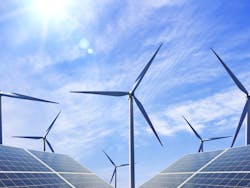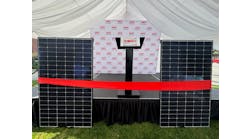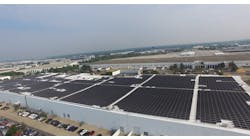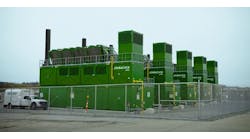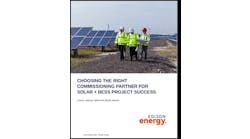Multinational mining corporation Gold Fields and global energy group EDL are rolling out the first hybrid microgrid to incorporate wind power at a mine in Australia.
Located at Gold Fields’ Agnew mine in Northern Goldfields, Western Australia, the microgrid combines 18 MW of wind power with 16 MW of baseload natural gas generation, 4 MW of solar and 13 MW/4 MWh-based energy storage.
Agnew is investing about $78.3 million to deploy the hybrid microgrid with expectations of reducing energy costs, enhancing energy reliability and resiliency and reducing the mining facility’s carbon and overall environmental footprint.
ARENA, the Australian Renewable Energy Agency, is pitching in another $9.41 million.
Under construction, the hybrid microgrid is expected to meet on average 55-65% of the gold mine’s energy needs while meeting nearly all its energy requirements some of the time, according to the companies.
Getting the most of batteries, renewables
The battery system is customized to deliver high rates of power for short durations so as to meet the mine site’s energy load profile. In addition, it will make use of dynamic load shedding, renewable resource forecasting and load management to maximize renewable energy while maintaining system security, according to the project partners.
EDL will own and operate the microgrid under a 10-year electricity supply agreement with Agnew. EDL CEO James Harman said that the microgrid will provide Agnew with greater than 50% renewable energy over the long term, without compromising power quality or reliability.
Australia doesn’t impose a tax on carbon emissions, but project partners considered the possibility of one in the future when assessing the microgrid’s feasibility. They also looked at the risk of rising natural gas prices, said Sven Lunsche, Gold Fields’ vice president of corporate affairs.
“Due to the multiple technologies integrated into the project, if the renewable energy contribution to the project is high, as is envisaged for most of the time, the cost is comparable to the gas-grid option. But if it is on the low side, the energy cost will be higher. The ARENA funding contribution to the project negates the low renewable energy contribution risk, and if the project performs even better, the savings will be paid back to ARENA,” Lunsche said.
The project’s cost per kilowatt-hour is a function of its expected life. There’s an upside for renewables if the microgrid continues to operate beyond expectations, Lunsche said. “Renewables are high capex, low opex and during extension the capex has been amortized and only the low opex costs continue.”
A blueprint for sustainable mines
Gold Fields describes itself as the third largest gold producer in Australia. It owns and operates three mines in Western Australia and is completing the construction of a fourth, Gruyere, in joint venture with Gold Road Resources.
The miner has been focusing on enhancing the sustainability of its operations. “The Agnew hybrid microgrid project reflects the company’s strategic objective to strengthen energy security, optimize energy costs and reduce its carbon footprint through innovation and the adoption of new technologies,” said Stuart Matthews, Gold Fields Australia executive vice president.
The Agnew mine microgrid breaks new ground for Gold Fields in terms of sustainability and renewable microgrid technology and configuration, e.g. incorporation of wind power generation. It also serves, as an example of the innovations the mining company aims to make use of at its mine sites in other parts of the world, Matthews said.
“The configuration of Agnew’s hybrid solution is a first for Gold Fields, and is an excellent example of using innovation and technology to improve efficiencies and lower costs. We are fast sharing lessons from this project with our other regions, as part of our global strategic initiatives to improve our security of supply and reduce carbon emissions,” Matthews said.
The project will use instrumentation to detect approaching cloud cover to gauge solar panel production. In the future it may also use instrumentation to detect changes in wind velocity. Based on this data, the gas power station will have forward-looking systems in place to schedule gas generators in response to forecast changes in the renewable energy supply.
Australian mining operation. Photo courtesy of Gold Fields
Second hybrid microgrid this year for Gold Fields
Gold Fields earlier this year announced it was rolling out a smaller, hybrid microgrid at its Granny Smith mine in Northern Goldfields. Akin to the Agnew project, the Granny Smith hybrid microgrid incorporates baseload natural gas power generation with 8 MW of solar PV and a 2 MW/1 MWh lithium-ion battery storage.
The South African mining company signed a deal with UK-based off-grid and remote power systems specialist Aggreko to design, build and operate the microgrid as per the terms of a power purchase, microgrid-as-a-service agreement.
ARENA said that the Agnew mine site project is the latest renewable energy-centered microgrid to help build a business case for renewables in mining. The federal government agency pointed to Rio Tinto’s Weipa project and Sandfire Resources’ DeGrussa Solar Project as others.
Track news about hybrid microgrids in mining. Subscribe to the free Microgrid Knowledge newsletter.
